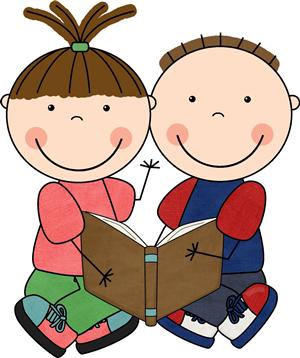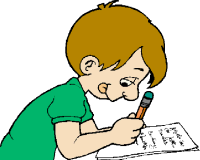- Harrison Elementary School
- Reading and Writing Workshop
-
Reading WorkshopFirst and Second Grade
 SeptemberWe are learning that readers are a lot like athletes...if you want to get better at sports, you must practice everyday to build your muscles. If you want to get better at reading, you must read every day to build your reading muscles! We started off this year reviewing expectations and procedures of reading workshop. We will begin each lesson with a mini lesson. Then, we are off to our reading spots to practice using those reading muscles during our independent reading time. Everyone is doing a wonderful job! We have been thinking about and discussing what books we like and where we like to read.
SeptemberWe are learning that readers are a lot like athletes...if you want to get better at sports, you must practice everyday to build your muscles. If you want to get better at reading, you must read every day to build your reading muscles! We started off this year reviewing expectations and procedures of reading workshop. We will begin each lesson with a mini lesson. Then, we are off to our reading spots to practice using those reading muscles during our independent reading time. Everyone is doing a wonderful job! We have been thinking about and discussing what books we like and where we like to read.
Soon, we will learn ways that readers can use the cover, take a book walk and make a movie in their mind to help warm up their reading muscles. We will also spend some time reading and talking about books with our partners.OctoberWe have been reviewing what good readers do when they get to tricky words. Just like builders need a variety of tools to help them build, it is very important to have a variety of tools/strategies to use while reading. Some of our tools are:
* picture clues
* think about what sounds right
* get our mouths ready by making the first sound
* reread
* think about what would make sense
* check the first letter and/or the last letter to make sure the word looks right
We are also using our words on our word wall to help us figure out unknown words. Looking for parts we know makes reading a snap!We have also been noticing if a book is fiction or non-fiction. We know that if a book is fiction it tells a story and if a book is non-fiction it tells us facts. We have been very busy reading many different versions of The Little Red Hen. We have been discussing the similarities and differences of each story and identifying the story elements including the characters, setting, problem and solution. Stay tuned for our own class rewrite...November/DecemberIn this unit, students will read to learn by exploring non-fiction texts. The students will have the opportunity to learn about the features of a nonfiction book which include pictures and captions, diagrams, charts, side bars and blow-ups. In addition, the students will also learn how to use a table of contents to locate information and a glossy to define unknown words.
We will learn how readers do thinking work before, during and after reading non-fiction books. Here is some of the thinking we will do:
Before reading:
- Readers warm up their brain by thinking what do I already know about this topic?
- Readers warm up their brain by thinking what words (vocabulary) do I expect to see in this book?
- Readers warm up their brain by thinking what do I want to know/wonder about this book?
During reading:
· Readers notice big feelings and reactions they have to what they are learning (ex. Ewww….that crocodile is so big or Awww….puppies are so cute when they are born)
· Readers notice when they learn a new fact and think more about it (Ex. “The nurse shark has long, curved teeth.” I think that is how they catch their prey.”)
· Readers wonder as they read (Ex. “The ice is melting and destroying polar bears’ homes. I wonder what we could do to save them?”)
After reading:
· Readers find the author’s big idea by thinking “what is the author tying to teach me? (the main idea)
· Readers find clues to support the big idea (supporting details)
When you are reading at home you can:
Stop and Jot- Good Readers use post-its to write down their findings and thoughts
- A new fact
- Make a connection
- The biggest/ the smallest
- Data collected from a graph
- A funny fact
- A question
- Tricky words
- Choose a favorite part
- Noticing bold or italic words
Writing WorkshopFirst and Second GradeSeptemberIn writing workshop, students have the opportunity to write everyday. We started off the year reviewing the expectations and procedures of writing workshop. We are beginning our small moment unit- true stories about our own lives. We are learning that writers have lots of stories to tell. These stories include specific details, small actions, thoughts and feelings.OctoberWe have learned that good writers:- Think, plan, sketch, and write
- Stretch out words- say it, slide it, hear it, write it
- Go back and add detail- Writers can show feeling in their pictures and describe the way the characters are feeling in the words of their stories. We can also tell the readers what the characters are saying by adding speech bubbles to the pictures.
Currently, we are learning that we can grow as writers by studying the work of a famous mentor author. During this unit the students are studying Ezra Jack Keats. We are reading lots of books by this author and are learning to notice many great things. We are learning how to use a setting to create a great lead that grabs the readers' attention, how to make creative font choices such as bold print, ALL CAPITALS, or d-a-s-h-e-s between letters to read slowly, and how to use onomatopoeia (sound words) to make our writing exciting!!
November/DecemberTo coincide with our non-fiction reading study, we have also been writing non-fiction texts called “How to” Informational texts in Writing Workshop. During this unit the students will have the opportunity to brainstorm topic ideas by thinking about things we do every day that we could teach others. The students will write their own how-to books on topics of their chose and share them with others. During the writing process the students will plan out their steps and sketch pictures to show each step. They will learn that adding labels to those sketches will make it easier for the reader. They will write sentences to match each step focusing on using detailed language to tell the reader exactly what we mean and add transitional words such as “first”, “next”, “after that”…etc. to the beginning of our sentences to help the reader. The book will include a detailed list of materials needed, the steps involved to make, create or complete whatever is being taught with examples and pictures, a diagram with labels, helpful tips, a dedication page and more.This unit will be kicked off by writing a class book- How to Make Pizza. Together as a class we will write the book and once completed we will follow the directions in our book and make pizza. While working together on a class book the students will learn through teacher modeling and experience before being asked to complete their own book. I am very excited about this unit. At home you can make How-To books and then follow the directions and have fun. Please send in any books you write together at home to share with the class.
- Readers warm up their brain by thinking what do I already know about this topic?


